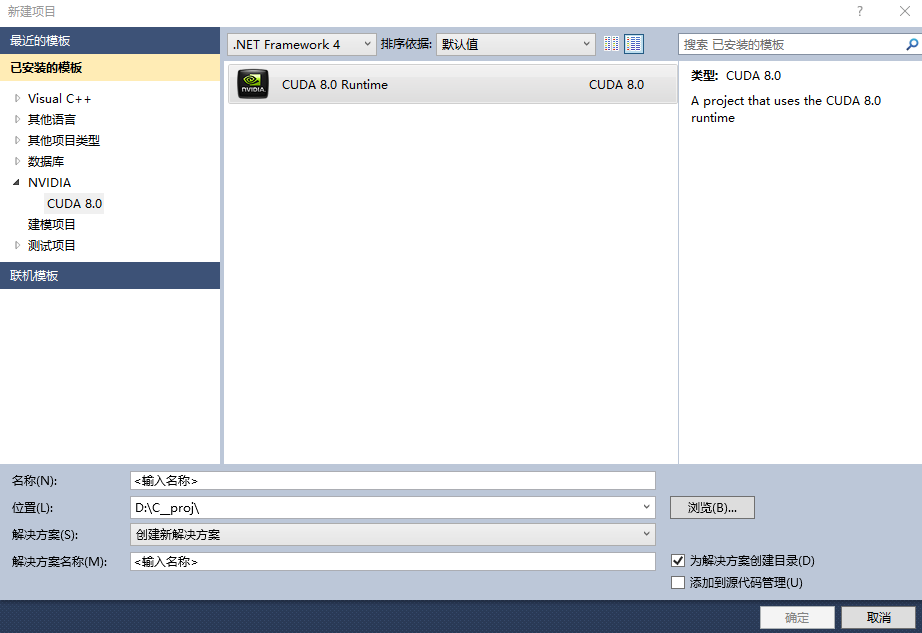CUDA-GPU编程
参考:http://blog.csdn.net/augusdi/article/details/12833235 第二节
新建NVIDIA项目:

新建项目及会生成一个简单的代码demo,计算矩阵的加法,如下(main中加了一些显示显卡性能的打印):
#include "cuda_runtime.h"
#include "device_launch_parameters.h" #include <stdio.h> cudaError_t addWithCuda(int *c, const int *a, const int *b, unsigned int size); __global__ void addKernel(int *c, const int *a, const int *b)
{
int i = threadIdx.x;
c[i] = a[i] + b[i];
} int main()
{
const int arraySize = ;
const int a[arraySize] = { , , , , };
const int b[arraySize] = { , , , , };
int c[arraySize] = { }; // Add vectors in parallel.
cudaError_t cudaStatus = addWithCuda(c, a, b, arraySize);
if (cudaStatus != cudaSuccess) {
fprintf(stderr, "addWithCuda failed!");
return ;
} printf("{1,2,3,4,5} + {10,20,30,40,50} = {%d,%d,%d,%d,%d}\n",
c[], c[], c[], c[], c[]); // cudaDeviceReset must be called before exiting in order for profiling and
// tracing tools such as Nsight and Visual Profiler to show complete traces.
cudaStatus = cudaDeviceReset();
if (cudaStatus != cudaSuccess) {
fprintf(stderr, "cudaDeviceReset failed!");
return ;
} int deviceCount;
cudaGetDeviceCount(&deviceCount);
int dev;
for (dev = ; dev < deviceCount; dev++)
{
cudaDeviceProp deviceProp;
cudaGetDeviceProperties(&deviceProp, dev);
if (dev == )
{
if (/*deviceProp.major==9999 && */deviceProp.minor = &&deviceProp.major==)
printf("\n"); }
printf("\nDevice%d:\"%s\"\n", dev, deviceProp.name);
printf("Total amount of global memory %u bytes\n", deviceProp.totalGlobalMem);
printf("Number of mltiprocessors %d\n", deviceProp.multiProcessorCount);
printf("Total amount of constant memory: %u bytes\n", deviceProp.totalConstMem);
printf("Total amount of shared memory per block %u bytes\n", deviceProp.sharedMemPerBlock);
printf("Total number of registers available per block: %d\n", deviceProp.regsPerBlock);
printf("Warp size %d\n", deviceProp.warpSize);
printf("Maximum number of threada per block: %d\n", deviceProp.maxThreadsPerBlock);
printf("Maximum sizes of each dimension of a block: %d x %d x %d\n", deviceProp.maxThreadsDim[],
deviceProp.maxThreadsDim[],
deviceProp.maxThreadsDim[]);
printf("Maximum size of each dimension of a grid: %d x %d x %d\n", deviceProp.maxGridSize[], deviceProp.maxGridSize[], deviceProp.maxGridSize[]);
printf("Maximum memory pitch : %u bytes\n", deviceProp.memPitch);
printf("Texture alignmemt %u bytes\n", deviceProp.texturePitchAlignment);
printf("Clock rate %.2f GHz\n", deviceProp.clockRate*1e-6f);
}
printf("\nTest PASSED\n"); getchar();
return ;
} // Helper function for using CUDA to add vectors in parallel.
cudaError_t addWithCuda(int *c, const int *a, const int *b, unsigned int size)
{
int *dev_a = ;
int *dev_b = ;
int *dev_c = ;
cudaError_t cudaStatus; // Choose which GPU to run on, change this on a multi-GPU system.
cudaStatus = cudaSetDevice();
if (cudaStatus != cudaSuccess) {
fprintf(stderr, "cudaSetDevice failed! Do you have a CUDA-capable GPU installed?");
goto Error;
} // Allocate GPU buffers for three vectors (two input, one output) .
cudaStatus = cudaMalloc((void**)&dev_c, size * sizeof(int));
if (cudaStatus != cudaSuccess) {
fprintf(stderr, "cudaMalloc failed!");
goto Error;
} cudaStatus = cudaMalloc((void**)&dev_a, size * sizeof(int));
if (cudaStatus != cudaSuccess) {
fprintf(stderr, "cudaMalloc failed!");
goto Error;
} cudaStatus = cudaMalloc((void**)&dev_b, size * sizeof(int));
if (cudaStatus != cudaSuccess) {
fprintf(stderr, "cudaMalloc failed!");
goto Error;
} // Copy input vectors from host memory to GPU buffers.
cudaStatus = cudaMemcpy(dev_a, a, size * sizeof(int), cudaMemcpyHostToDevice);
if (cudaStatus != cudaSuccess) {
fprintf(stderr, "cudaMemcpy failed!");
goto Error;
} cudaStatus = cudaMemcpy(dev_b, b, size * sizeof(int), cudaMemcpyHostToDevice);
if (cudaStatus != cudaSuccess) {
fprintf(stderr, "cudaMemcpy failed!");
goto Error;
} // Launch a kernel on the GPU with one thread for each element.
addKernel<<<, size>>>(dev_c, dev_a, dev_b); // Check for any errors launching the kernel
cudaStatus = cudaGetLastError();
if (cudaStatus != cudaSuccess) {
fprintf(stderr, "addKernel launch failed: %s\n", cudaGetErrorString(cudaStatus));
goto Error;
} // cudaDeviceSynchronize waits for the kernel to finish, and returns
// any errors encountered during the launch.
cudaStatus = cudaDeviceSynchronize();
if (cudaStatus != cudaSuccess) {
fprintf(stderr, "cudaDeviceSynchronize returned error code %d after launching addKernel!\n", cudaStatus);
goto Error;
} // Copy output vector from GPU buffer to host memory.
cudaStatus = cudaMemcpy(c, dev_c, size * sizeof(int), cudaMemcpyDeviceToHost);
if (cudaStatus != cudaSuccess) {
fprintf(stderr, "cudaMemcpy failed!");
goto Error;
} Error:
cudaFree(dev_c);
cudaFree(dev_a);
cudaFree(dev_b); return cudaStatus;
}
CUDA-GPU编程的更多相关文章
- 《CUDA并行程序设计:GPU编程指南》
<CUDA并行程序设计:GPU编程指南> 基本信息 原书名:CUDA Programming:A Developer’s Guide to Parallel Computing with ...
- GPU编程自学4 —— CUDA核函数运行参数
深度学习的兴起,使得多线程以及GPU编程逐渐成为算法工程师无法规避的问题.这里主要记录自己的GPU自学历程. 目录 <GPU编程自学1 -- 引言> <GPU编程自学2 -- CUD ...
- GPU编程自学3 —— CUDA程序初探
深度学习的兴起,使得多线程以及GPU编程逐渐成为算法工程师无法规避的问题.这里主要记录自己的GPU自学历程. 目录 <GPU编程自学1 -- 引言> <GPU编程自学2 -- CUD ...
- GPU编程自学2 —— CUDA环境配置
深度学习的兴起,使得多线程以及GPU编程逐渐成为算法工程师无法规避的问题.这里主要记录自己的GPU自学历程. 目录 <GPU编程自学1 -- 引言> <GPU编程自学2 -- CUD ...
- 【OpenCV & CUDA】OpenCV和Cuda结合编程
一.利用OpenCV中提供的GPU模块 目前,OpenCV中已提供了许多GPU函数,直接使用OpenCV提供的GPU模块,可以完成大部分图像处理的加速操作. 基本使用方法,请参考:http://www ...
- CUDA 标准编程模式
前言 本文将介绍 CUDA 编程的基本模式,所有 CUDA 程序都基于此模式编写,即使是调用库,库的底层也是这个模式实现的. 模式描述 1. 定义需要在 device 端执行的核函数.( 函数声明前加 ...
- 第一篇:GPU 编程技术的发展历程及现状
前言 本文通过介绍 GPU 编程技术的发展历程,让大家初步地了解 GPU 编程,走进 GPU 编程的世界. 冯诺依曼计算机架构的瓶颈 曾经,几乎所有的处理器都是以冯诺依曼计算机架构为基础的.该系统架构 ...
- GPU 编程入门到精通(五)之 GPU 程序优化进阶
博主因为工作其中的须要,開始学习 GPU 上面的编程,主要涉及到的是基于 GPU 的深度学习方面的知识.鉴于之前没有接触过 GPU 编程.因此在这里特地学习一下 GPU 上面的编程. 有志同道合的小伙 ...
- mpi和cuda混合编程的正确编译
针对大数据的计算,很多程序通过搭建mpi集群进行加速,并取得了很好的效果.算法内部的加速,当前的并行化趋势是利用GPU显卡进行算法加速.针对并行性非常好的算法,GPU加速效果将远大于集群带来的加速效果 ...
- GPU编程--宏观理解篇(1)
GPU编程与CPU编程最大的不同可以概括为以下两点: "The same program is executed on many data elements in parallel" ...
随机推荐
- 0213微信ZABBIX报警
简介 微信作为日常使用最频繁的工具,因此希望将微信接入zabbix报警. 微信企业号 1.申请微信企业号 申请后,请在“我的企业”页面下记录企业号的CorpID 2.添加通讯录 部门添加完成后,根据实 ...
- SQL Server死锁总结 [转]
1. 死锁原理 根据操作系统中的定义:死锁是指在一组进程中的各个进程均占有不会释放的资源,但因互相申请被其他进程所站用不会释放的资源而处于的一种永久等待状态. 死锁的四个必要条件:互斥条件(Mutua ...
- Json解析工具Jackson(使用注解)--jackson框架自定义的一些json解析注解
Json解析工具Jackson(使用注解)--jackson框架自定义的一些json解析注解 @JsonIgnoreProperties 此注解是类注解,作用是json序列化时将Javabean中的一 ...
- JAVA包装类的缓存范围
JAVA包装类的缓存范围 前两天面试遇到两个关于JAVA源码的问题,记录下来提醒自己. 1.写出下面的输出结果 System.out.println(Integer.valueOf("100 ...
- Oracle移除表空间的数据文件 ora-00604 ora-01426
项目背景:在之前开发环境数据库管理比較乱,在表空间不足时仅仅是加入数据文件,測试完后数据己删除,但数据库表空间所占的空间不能回收,导致数据库的存储文件夹使用率达到97%以上实际使用仅仅有10%, ...
- 自然语言处理中的Attention Model:是什么及为什么
/* 版权声明:能够随意转载.转载时请标明文章原始出处和作者信息 .*/ author: 张俊林 要是关注深度学习在自然语言处理方面的研究进展,我相信你一定听说过Attention Model(后文有 ...
- C# 文件里的类不能进行设计,因此未能为该文件显示设计器
C# 文件里的类不能进行设计,因此未能为该文件显示设计器 vs 一直打不开设计界面 仅仅能查看代码界面 这时候须要查看 代码中 是不是 从 form 继承 假设不是 窗口类型 改为 fo ...
- Why is processing a sorted array faster than an unsorted array(Stackoverflow)
What is Branch Prediction? Consider a railroad junction: Image by Mecanismo, via Wikimedia Commons. ...
- Asp.NET之对象学习
一.总述 二.具体介绍 1.Request对象 Request对象是用来获取client在请求一个页面或传送一个Form时提供的全部信息,这包含可以标识浏览器和用户的HTTP变量,存储在client的 ...
- Android隐藏状态栏和标题栏,相当于全屏效果
隐藏标题栏需要使用预定义样式:android:theme=”@android:style/Theme.NoTitleBar”. 隐藏状态栏:android:theme=”@android:style/ ...
